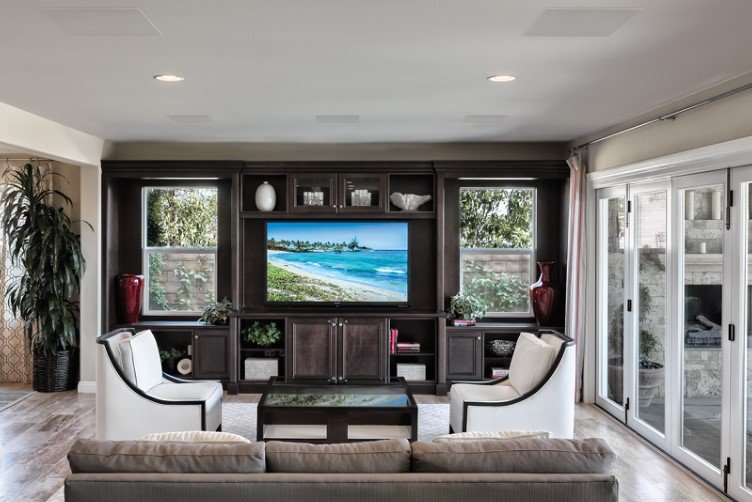Do you have a spare room in your home that you rarely use? Why not turn it into a media room where you can enjoy movies, games, and music with your family and friends? A media room is a great way to add value and entertainment to your home. In this article, we will show you how to create the ultimate media room in your home with some simple steps and tips.

Choose the Right Room
The first step to creating a media room is to choose the right room for it. Ideally, you want a room that is large enough to accommodate your screen, speakers, seating, and other equipment. You also want a room that has minimal natural light and noise, as these can interfere with your viewing experience. A basement, attic, or garage can be good options for a media room, as they are usually isolated from the rest of the house. However, you can also use any spare bedroom or living room, as long as you can control the light and sound.
Plan the Layout
The next step is to plan the layout of your media room. You need to decide where to place your screen, speakers, seating, and other furniture and accessories. You also need to consider the wiring and ventilation of your equipment, as well as the acoustics and aesthetics of your room. Here are some tips to help you plan the layout:
- Screen: The screen is the focal point of your media room, so you want to place it on the wall opposite the main entrance. You also want to make sure that the screen is at a comfortable viewing height and distance from your seating. A good rule of thumb is to multiply the diagonal size of your screen by 1.5 to get the optimal viewing distance in inches. For example, if you have a 60-inch screen, you want to sit about 90 inches away from it. You can use a projector and a screen or a large flat-screen TV, depending on your preference and budget.
- Speakers: The speakers are the second-most important element of your media room, as they provide the sound effects and ambiance for your movies and games. You want to place your speakers in a way that creates a surround sound effect, which means having at least five speakers and a subwoofer. You can follow the 5.1-channel setup, which consists of a center speaker, two front speakers, two rear speakers, and a subwoofer. You want to place the center speaker below or above the screen, the front speakers on either side of the screen, the rear speakers behind your seating, and the subwoofer in a corner or near a wall.
- Seating: Seating is the third most important element of your media room, as it determines how comfortable and enjoyable your viewing experience will be. You want to choose seating that is cozy, spacious, and ergonomic. You can use sofas, recliners, bean bags, or theater seats, depending on your style and budget. You also want to arrange your seating in a way that allows everyone to have a clear view of the screen and access to the speakers. You can use risers, platforms, or tiers to create different levels of seating if you have a large room and a lot of guests.
- Furniture and Accessories: The furniture and accessories are the final touches that make your media room more functional and attractive. You want to choose furniture and accessories that match your theme and style, as well as your needs and preferences. You can use tables, cabinets, shelves, or racks to store and display your media devices, discs, games, and controllers. You can also use lamps, curtains, rugs, pillows, blankets, or posters to add some color, texture, and personality to your room.
Install the Equipment
The third step is to install the equipment for your media room. You need to connect your screen, speakers, media devices, and other gadgets with the appropriate cables, plugs, and outlets. You also need to set up the remote controls, apps, and settings for your equipment. Here are some tips to help you install the equipment:
- Screen: The screen is the most delicate and expensive part of your media room, so you want to install it carefully and securely. You can use a wall mount, a ceiling mount, or a stand to support your screen, depending on the type and size of your screen. You also want to make sure that the screen is level, stable, and aligned with your seating and speakers. You can use a level, a tape measure, a stud finder, and a drill to install your screen. You also want to hide the wires and cables behind the wall, the ceiling, or the furniture to avoid clutter and tripping hazards.
- Speakers: The speakers are the most complex and challenging part of your media room, as they require a lot of wiring and calibration. You can use wireless speakers, which are easier to install and move, or wired speakers, which are more reliable and powerful. You also want to make sure that the speakers are balanced, synchronized, and adjusted to your room size and shape. You can use a sound meter, a receiver, and a test tone to calibrate your speakers. You also want to hide the wires and cables behind the wall, the ceiling, or the furniture to avoid clutter and tripping hazards.
- Media Devices: The media devices are the most diverse and versatile part of your media room, as they provide the content and entertainment for your movies and games. You can use a Blu-ray player, a streaming device, a gaming console, a cable box, or any other device that connects to your screen and speakers. You also want to make sure that the media devices are compatible, accessible, and organized. You can use an HDMI switch, a universal remote, and a media center to connect and control your media devices. You also want to hide the wires and cables behind the wall, the ceiling, or the furniture to avoid clutter and tripping hazards.
Decorate the Room
The fourth and final step is to decorate the room for your media room. You need to choose the colors, materials, and styles that suit your taste and theme. You also need to consider the lighting, soundproofing, and comfort of your room. Here are some tips to help you decorate the room:
- Colors: The colors are the most noticeable and influential part of your media room, as they affect the mood and atmosphere of your room. You want to choose colors that are dark, neutral, and matte, as they reduce the glare and reflection of the screen and speakers. You can use black, gray, brown, or navy for the walls, ceiling, and floor. You can also use some pops of color, like red, yellow, or green, for the furniture and accessories to add some contrast and interest to your room.
- Materials: The materials are the most practical and functional part of your media room, as they affect the durability and quality of your room. You want to choose materials that are sturdy, smooth, and sound-absorbent, as they will protect and enhance your equipment and experience. You can use wood, metal, or plastic for the furniture and accessories. You can also use fabric, carpet, or foam for the curtains, rugs, and pillows to add some softness and warmth to your room.
- Styles: The styles are the most personal and creative part of your media room, as they reflect your personality and preferences. You want to choose styles that are modern, sleek, and cozy, as they match and complement your equipment and experience. You can use contemporary, minimalist, or industrial for the furniture and accessories. You can also use themed, customized, or eclectic curtains, rugs, and posters to add some character and fun to your room.
Enjoy Your Media Room
You have now created the ultimate media room in your home. You can enjoy watching movies, playing games, and listening to music with your family and friends. You can also host parties, events, and gatherings in your media room. You can also update, upgrade, and modify your media room as you wish. You have a media room that is comfortable, functional, and attractive. You have a media room that is yours.






